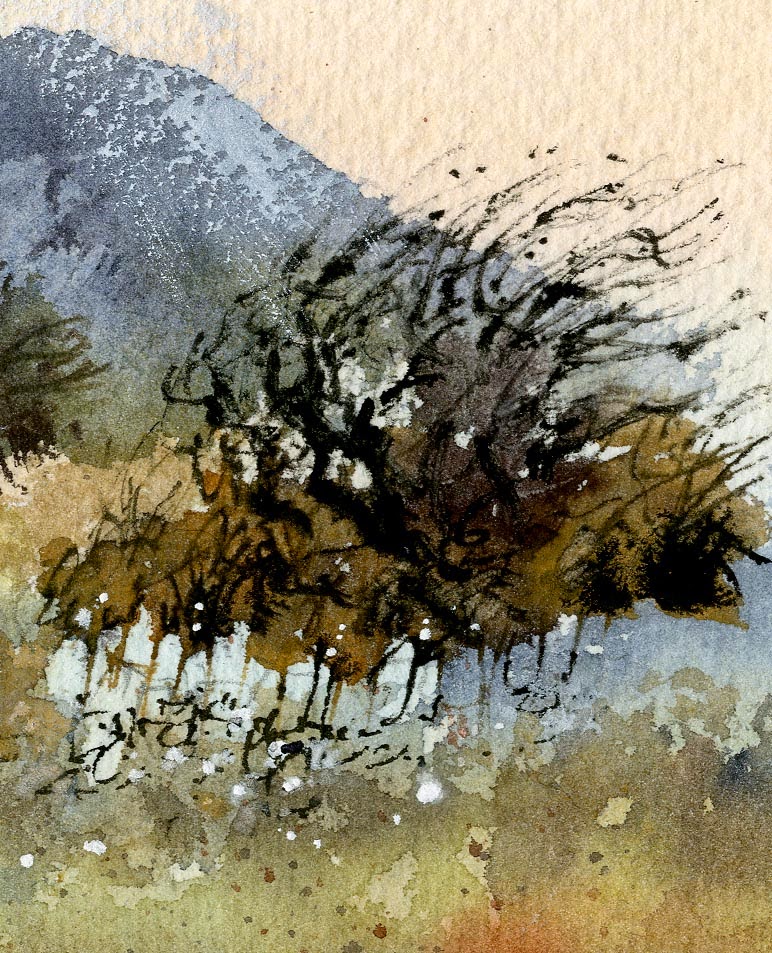Artists who work solely from photographs really do miss out on those marvellous energizing sensations of being tossed around in the wind, or being spattered in face and sketchbook by rain, snow, hail, or whatever. These sensations link you with the natural world, and provide a tremendous advantage when you wish to really make your paintings more dynamic and full of movement. But, of course, not everyone wishes to go through such experiences.
This section of drystone wall and wind-swept bush is part of a watercolour painting where I began with masking fluid painted over where the stonework would appear. The dark bush throws up a strong tonal contrast with the top of the wall, and after this had dried I removed the masking fluid and brushed a light blue-grey wash over the right-hand end of the wall to subdue that part.
For the branches I mixed some burnt umber and French ultramarine and applied it with a number 1 rigger. To give a sense of strong wind and movement I painted with vigorous strokes outwards from the centre of the bush. When this was done I spattered a number of small blobs or spots with the same mixture, to further enhance the feeling of robust movement in the branches. With all the branches bent in the same direction it suggests a rather windy day.
Watch for these effects when you are out and about, and note them, even if you don’t have a sketchbook or camera with you. You can, of course, include them in a composition where there is no wind, just to liven things up a but, or to create a sense of movement. This can be really effective on water – I’ve just returned from a few days in London and when sketching on the Thames the water was alive in the wind, creating a real sense of sparkling movement in the sunshine.
Have a go at this more vigorous approach – it really does give your work a marvellous boost.


 If you keep an eye on the weather forecast you might get some idea of what’s to come, but they seem to get it so wrong so often that it pays to be prepared for those glorious days when conditions are just right, whether snow is on the ground or not. If it takes you an hour or more to get your art gear together then you may well have lost the best part of the day, so having all your kit ready for action is vital. As far as keeping warm and dry is concerned, you can see in the photo that I am wrapped up in a warm fleece jacket, a warm sheepskin hat, scarf and thin gloves in which I can sketch quite happily. My trousers are lined, I have woollen socks and boots, thermal vest and inside the rucsack is my waterproof outer gear, a long neck tube which can cover not just my neck but up over my head as well, if need be, a steel thermos flask, mug, etc, so that I can make soup, coffee, tea, cappuccinos, the lot. I’m there to enjoy myself, so why not?
If you keep an eye on the weather forecast you might get some idea of what’s to come, but they seem to get it so wrong so often that it pays to be prepared for those glorious days when conditions are just right, whether snow is on the ground or not. If it takes you an hour or more to get your art gear together then you may well have lost the best part of the day, so having all your kit ready for action is vital. As far as keeping warm and dry is concerned, you can see in the photo that I am wrapped up in a warm fleece jacket, a warm sheepskin hat, scarf and thin gloves in which I can sketch quite happily. My trousers are lined, I have woollen socks and boots, thermal vest and inside the rucsack is my waterproof outer gear, a long neck tube which can cover not just my neck but up over my head as well, if need be, a steel thermos flask, mug, etc, so that I can make soup, coffee, tea, cappuccinos, the lot. I’m there to enjoy myself, so why not?

